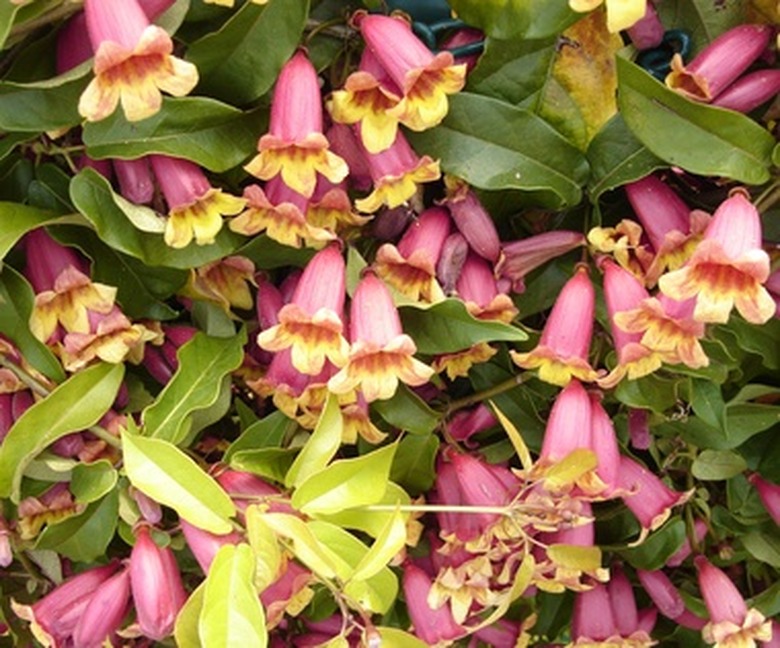The Trumpet Honeysuckle Plant
The trumpet honeysuckle ("Lonicera sempervirens") is a vigorously growing, twining vine that features attractive, trumpet-shaped flowers. Native to the United States, it is not considered an invasive plant like its relation, the Japanese honeysuckle. The trumpet honeysuckle is desirable as a climbing vine due to its orange, pink or red blossoms and the fact that it flowers from early spring through late summer. It is also easy to care for, according to information provided by the horticulture department of the University of Connecticut.
Appearance
The trumpet honeysuckle can reach heights of 20 feet, if a strong support structure is provided for the vine. The ovate leaves are between 1 and 3 inches long and are burgundy when they first uncurl, turning bluish-green later in the summer and remaining green throughout the summer, dropping off the vine while still green in early fall. The tubular flowers are orange or red on the outside and yellow on the inside. They grow up to 2 inches long and hang in clusters from the vine. The honeysuckle vine produces small, dark-red berries in September.
- The trumpet honeysuckle ("Lonicera sempervirens") is a vigorously growing, twining vine that features attractive, trumpet-shaped flowers.
- The trumpet honeysuckle is desirable as a climbing vine due to its orange, pink or red blossoms and the fact that it flowers from early spring through late summer.
Climate
Trumpet honeysuckles can grow in a wide variety of climates, depending on the cultivar, but in general they are good up to United States Department of Agriculture (USDA) growing zone 4. Some cold-hardy cultivars, such as "Supurba," can even thrive in growing zone 3. When planted in USDA zones 7 through 10, the vine will flower year-round, according to Edward F. Gilman, a horticulturist with the University of Florida.
Culture
Trumpet honeysuckles prefer well-draining, loose soil with a neutral pH level (around 4.0). These vines will grow well in full sunlight or partial shade, and can tolerate clay and sandy soils. While trumpet honeysuckles prefer cool, moist soil, they are also drought-tolerant. Water the vine when the top inch or so of soil dries out, and more often during long, hot periods of dry weather.
- Trumpet honeysuckles can grow in a wide variety of climates, depending on the cultivar, but in general they are good up to United States Department of Agriculture (USDA) growing zone 4.
Uses
The flowers of the trumpet honeysuckle are very attractive to hummingbirds, according to Mr. Gilman. For that reason, and because the long, thin stems of the plant droop gracefully, these vines are a great choice for hanging baskets. The trumpet honeysuckle is also excellent when allowed to climb along a fence, and can provide shade when trained over an arbor.
Problems
This plant does not suffer from any serious pest problems or diseases, according to Mr. Gilman, but there are some insects and fungi that can disfigure the vine. The trumpet honeysuckle can become infested with aphids, which suck the juices out of the leaves, or leaf-rollers, which roll-up infested leaves. Pluck or prune off infested leaves or branches by hand. If the vine is completely covered with these or other insects, such as scale, treat it with an insecticidal soap. Some fungi can cause leaf spot, which is unattractive but not life-threatening to the vine. A systematic application of fungicide in the spring can prevent leaf spot.
- The flowers of the trumpet honeysuckle are very attractive to hummingbirds, according to Mr. Gilman.
- The trumpet honeysuckle can become infested with aphids, which suck the juices out of the leaves, or leaf-rollers, which roll-up infested leaves.
